
Oncidium 'Musterland Stern'
Contents
- Top Tips
- Location, Water, Humidity & Fertilisation
- Dormancy Care & Annual Flowers
- Common Issues
- Origins, Temperature, Propagation, Repotting & Toxicity.
Need the answer to a specific plant query? Book a 1-to-1 video call with THE HOUSEPLANT DOCTOR™, the website's friendly author, to overcome and address your niggling problem! Available on iMessage, WhatsApp, Facebook Messenger & more.
Top Tips & Info
- Care Difficulty - Easy to Moderate
- Provide a bright, indirect location for good quality growth. The soil must also be able to see the natural light as soil mould is a common issue with too shady locations.
- Keep the soil evenly moist, allowing the top third to dry out in between hydrations. Reduce waters over the autumn and winter to replicate its dormancy period. Avoid persistent droughts and the use of cold water whilst in bloom.
- Although average room humidity will be accepted by an Oncidium, introduce a pebble tray while the heaters are operating to downplay dry air and browned leaf-tips. Too low humidity may cause a shortened lifespan of the individual flower, too.
- Fertilise with an Orchid-labelled feed once a month for good quality growth. You can either use a liquid feed or a Foliage Mister for supplementation.
- Read the third section (Dormancy Care & Annual Flowers) to learn about re-blooming Oncidiums in the winter and spring months!
- Repot every three to four years using an Orchid Bark and a slightly larger pot, during the spring; remember that Orchids will flower better and for longer if their root systems are restricted for several seasons.
Location & Light - 🔸🔸
Oncidiums like to be situated in the brightest location without the risk of sun exposure. As the plants grow epiphytic on trees, the thick canopy high above will defuse or block the harsh rays from penetrating the leaves. You must also allow the soil to see the natural light, as organic matter (like Orchid Bark) is highly likely to develop mould if the light is too low.
During the dormancy period in the autumn and winter (also the typical flowering time), move the plant into a brighter location with the possibility of morning sun. The ideal location would be somewhere that dips to around 15°C (59°F) during the night with good airborne moisture - a bathroom window comes to mind.
Water - 🔸🔸
Oncidiums will produce thicker pseudobulbs which will earn the ability to withhold moisture and nutrients in times of droughts. Although short-lived dry spells shouldn't be a frequent occasion, it's good to know that the plant does, in fact, have a 'back up' plant for if you do forget to water. Allow the top third to dry out in between waters, feeling the pot's weight for confirmation; if it still feels heavy when lifted, this isn't the time for another hydration. During the dormancy period in the autumn and winter, be sure not to over-water as the longer nights and shortened daylight hours will slow the water-uptake by the plant, heightening the risk of root rot. Under-watering symptoms include flower loss, pale leaves, stunted growth and a gradual decline in health. Never allow full sun or forgetfulness to take over, as both will result in a premature flower loss and a weakened plant. Over-watering symptoms include lower yellowing of leaves, a rapidly declining stem, flower loss and a rotten base (pseudobulbs). These issues are commonly down to either too much soil moisture, an incorrect soil medium, too little light, or foliage that has allowed to remain wet for long periods. Click here to learn more about repotting with root rot.
Humidity - 🔸🔸🔸
Create a humidity tray to provide a moist and stable environment for your plant. If the surrounding saturation is too low or the heat too high, its leaf-tips may start to brown over and curl, especially in direct sunlight. Hose the foliage down from time to time to hydrate the leaves and keep the dust levels down.
Fertilisation - 🔸🔸
Although regular plant food isn't ideal, it won't do too much damage to the plant's overall health. Orchid Feeds are purely tailored for all members of the Orchidaceæ Family, that can be in the guise of drip feeders or dilatable bottles. Many varieties of Oncidium have open-stomata whereby the leaves can absorb atmospheric nutrients. With this in mind, purchase a foliar feed (along with monthly soil fertilisations) to supplement the Orchid throughout the year, especially during the spring.
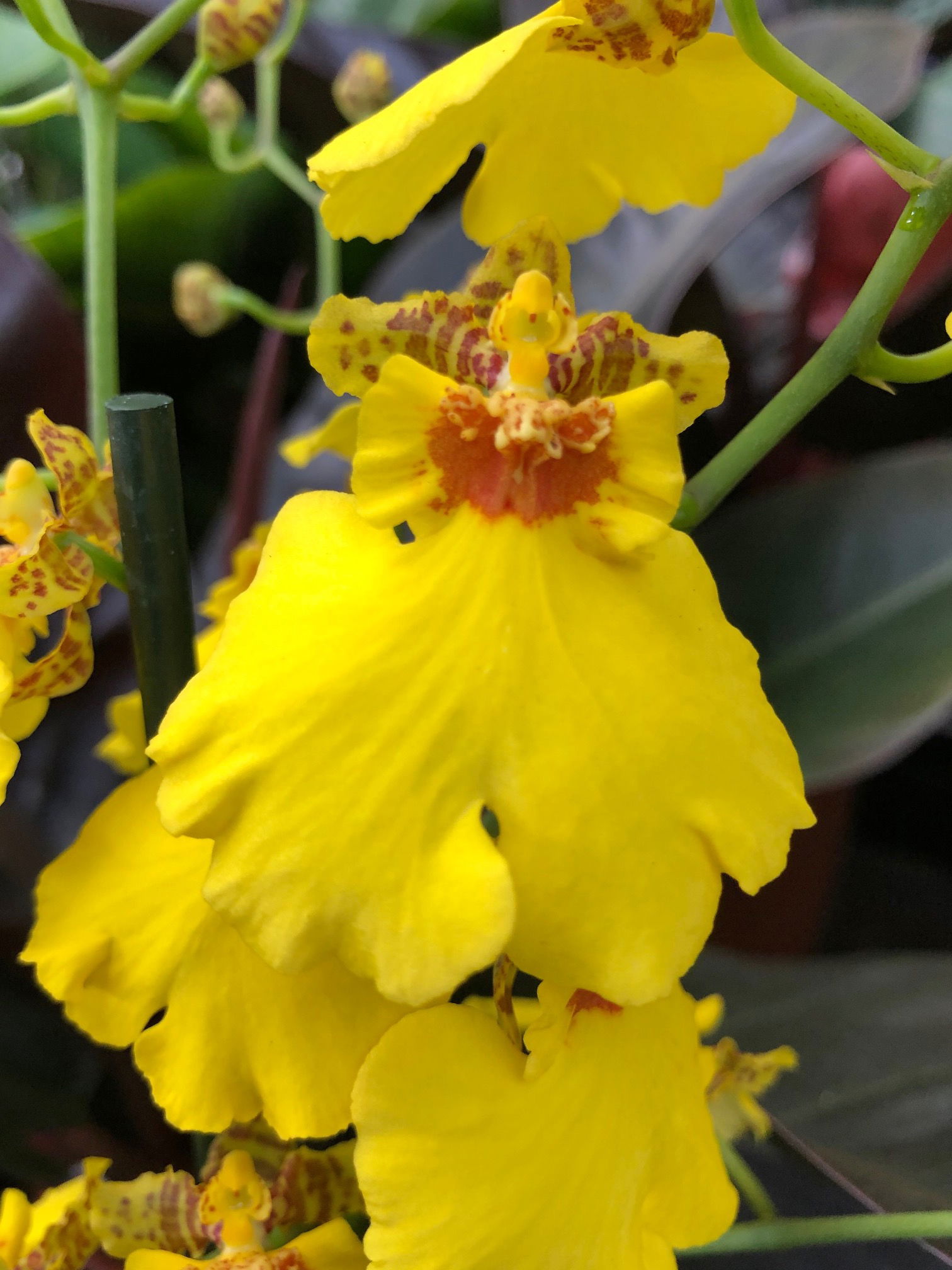 Oncidiums will hold up to twenty flowers per shaft, producing a show of blooms for around eight weeks.
Oncidiums will hold up to twenty flowers per shaft, producing a show of blooms for around eight weeks.
Dormancy Care & Annual Flowers
Oncidium blooms are easily achieved when its dormancy irrigations are reduced by half, with those who have a cooler room without artificial light at night being on the upper-hand, too. Keep the roots pot-bound to add further stress onto the specimen, which in turn will significantly heighten the chance of flowering. Blooms will generally appear at the start winter, but may occur slightly later in the spring months.
N. B - The following steps should be performed from the autumn through until early spring during their dormancy.
Sunlight & Location
Be sure to provide a bright location with little to no direct sunlight. Although the winter rays won't necessarily hurt the plant, be careful not to fall in the trap of sun-scorch and severe dehydration.
For a specimen to fully become seasoned, avoid the use of artificial lighting or locations that boast temperatures higher than 18℃ (64℉).
Hydration
Reduce waters so that about half of the soil becomes dry. It's essential to keep them on the drier side to life, as they'll think that hard times are ahead and therefore will need to pass its genes on to the next generation.
Occasional Feeds
Whilst in bloom, use a Tomato feed to provide monthly nourishment of potassium; the use of fertiliser isn't needed until the first flower spike emerges from the stem.
Reduce Everything
This one is to remind you that everything needs to be reduced - especially the temperature.
Temperature
This is the most significant step; reduce the temperature down by around 5℃ compared to the summertime or place in a room that's between 14 - 17℃ (57 - 62℉). The drop in temperature should ideally last until the inflorescence finishes blooming, although it can still be transferred into the main house as long as it sits on a pebble tray. You'll be at a significant disadvantage if the ambient temperature is kept constant throughout the year, as Oncidiums will only respond with flowers in cooled environments. Never exceed the minimum temperature as it could lead to plant death or yellowed foliage at a bare minimum.
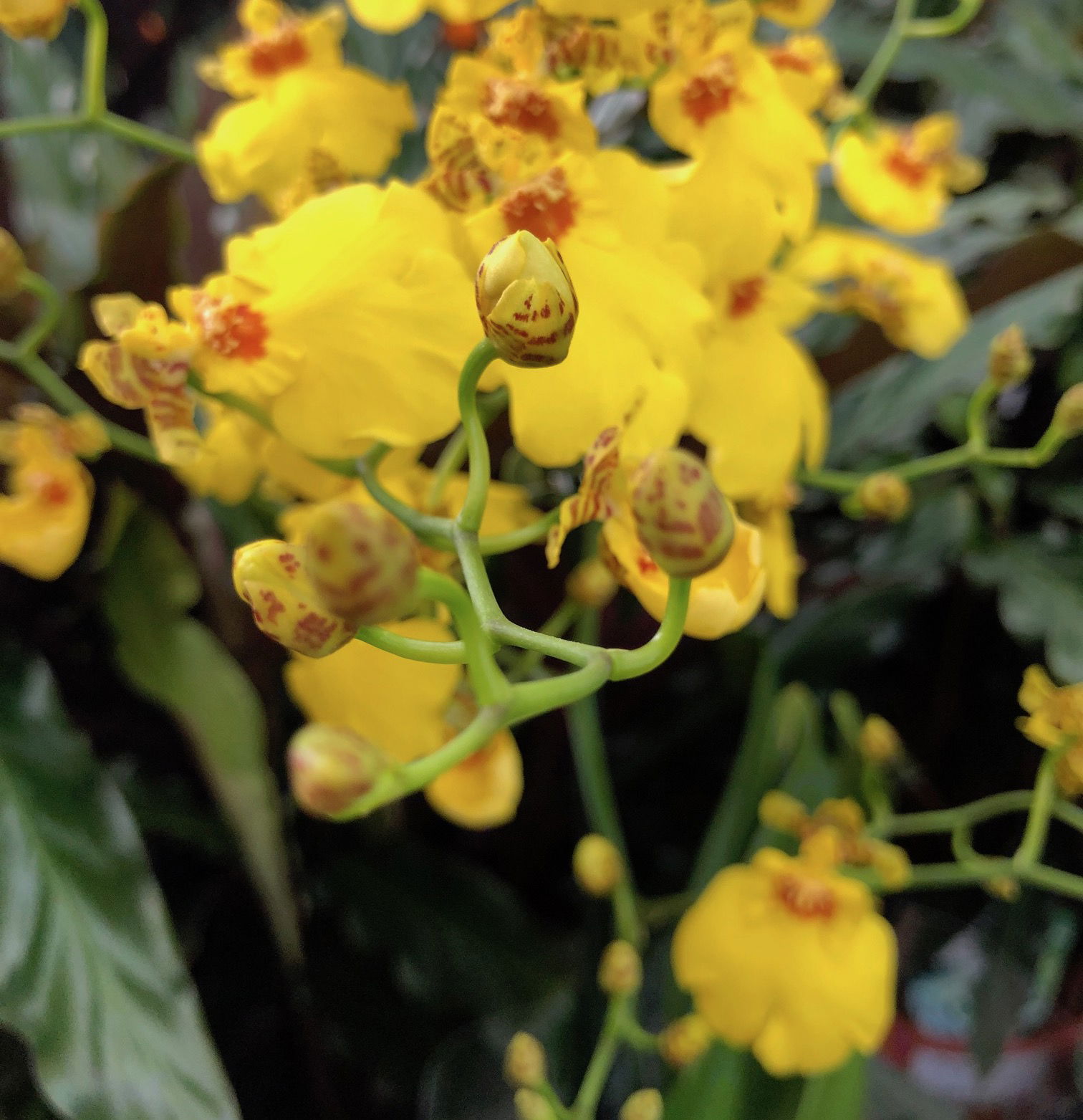 Remember not to use cold water while hydrating your Oncidium as it may result in sudden flower loss. Allow the top third of the soil to dry in between waters during the blooming process, reducing this slightly after the final flower elapses.
Remember not to use cold water while hydrating your Oncidium as it may result in sudden flower loss. Allow the top third of the soil to dry in between waters during the blooming process, reducing this slightly after the final flower elapses.
Common Issues with Oncidiums
A lack of flowers is caused by an insufficient dormancy period, where the temperatures are kept more or less the same over the year. Reduce the temperature by a couple of degrees over the autumn and winter months, along with fewer irrigations. Scroll up to 'Dormancy Care & Annual Blooms' for more information regarding this issue!
A sudden loss of older flowers that become dry and collapsed is a sign of prolonged droughts. Especially during the flowering process, near-continuous moist bark is mandatory for extended blooms; increase the waters and humidity (via a pebble tray) to reduce the rates of transpiration.
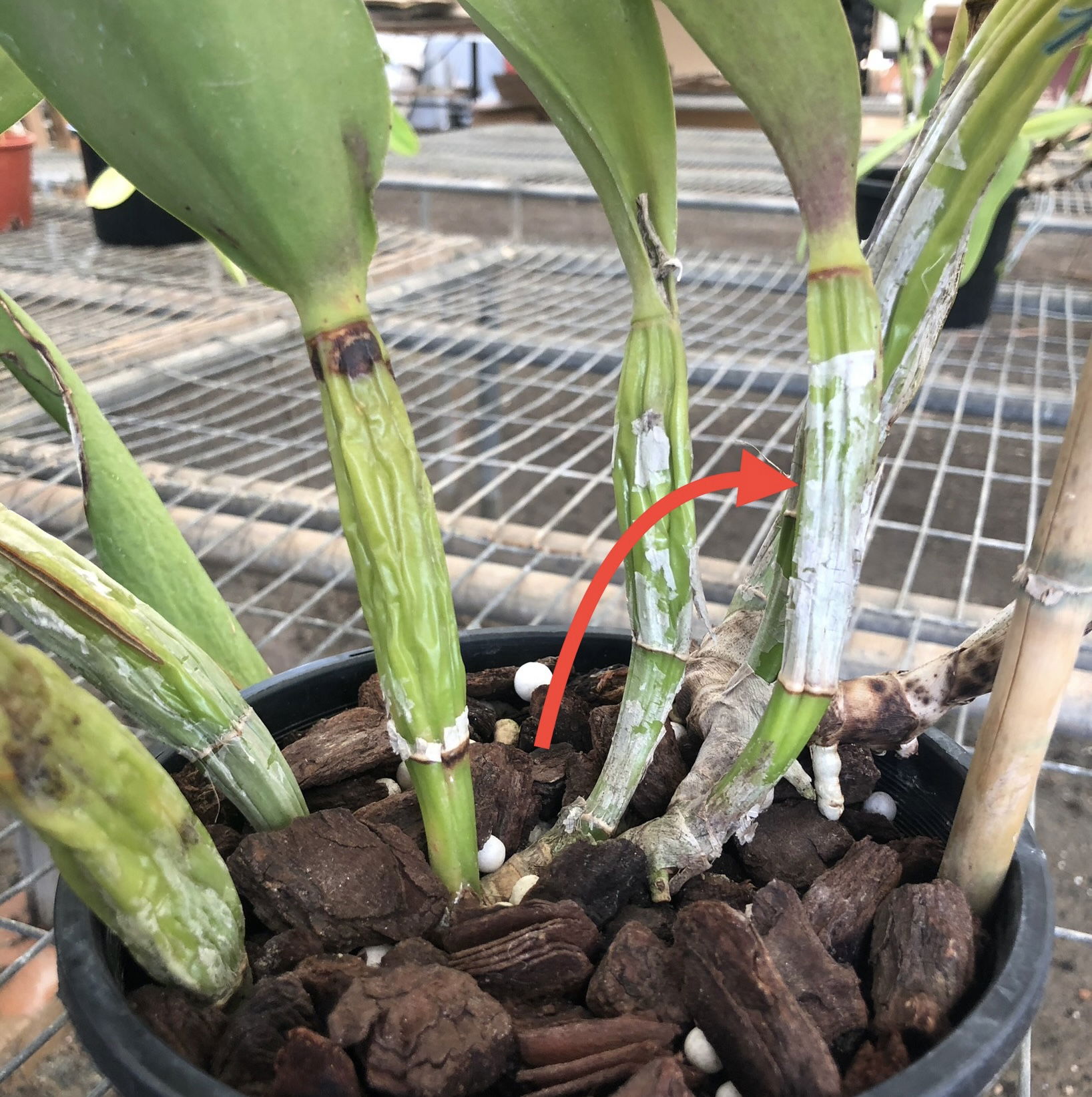 Silver flaky coverings (sheathes) are entirely natural on Oncidiums and don't pose any threat to its health.
Silver flaky coverings (sheathes) are entirely natural on Oncidiums and don't pose any threat to its health.
Directly pinpointing yellow leaves is quite hard due to the many different issues that could be at fault. Problems include watering-related abuse, too much or too little light, and fertilisation issues. If you'd like to speak to ukhouseplants in regards to this issue, be sure to book a 1-to-1 video call for more detailed advice. Always remember that the gradual yellowing of older leaves is wholly natural, and is just a byproduct of maturity.
Root rot is a common issue with specimens sat in too moist or waterlogged soil for long periods. Symptoms include rapidly yellowing leaves, stunted growth and a rotten pseudobulb. Take the plant out of the pot and inspect health below the soil line. If the roots sport a yellow tinge, you're good to go, but if they're brown and mushy, action must be taken immediately. More information about addressing root rot can be found on this link.
Short-lived flowers could be the product of low humidity. Place the Orchid on a humidity/pebble tray, keeping the reservoir topped up with water while the heaters are operating. Never mist the flowers due to the high risk of developing Botrytis Petal Blight.
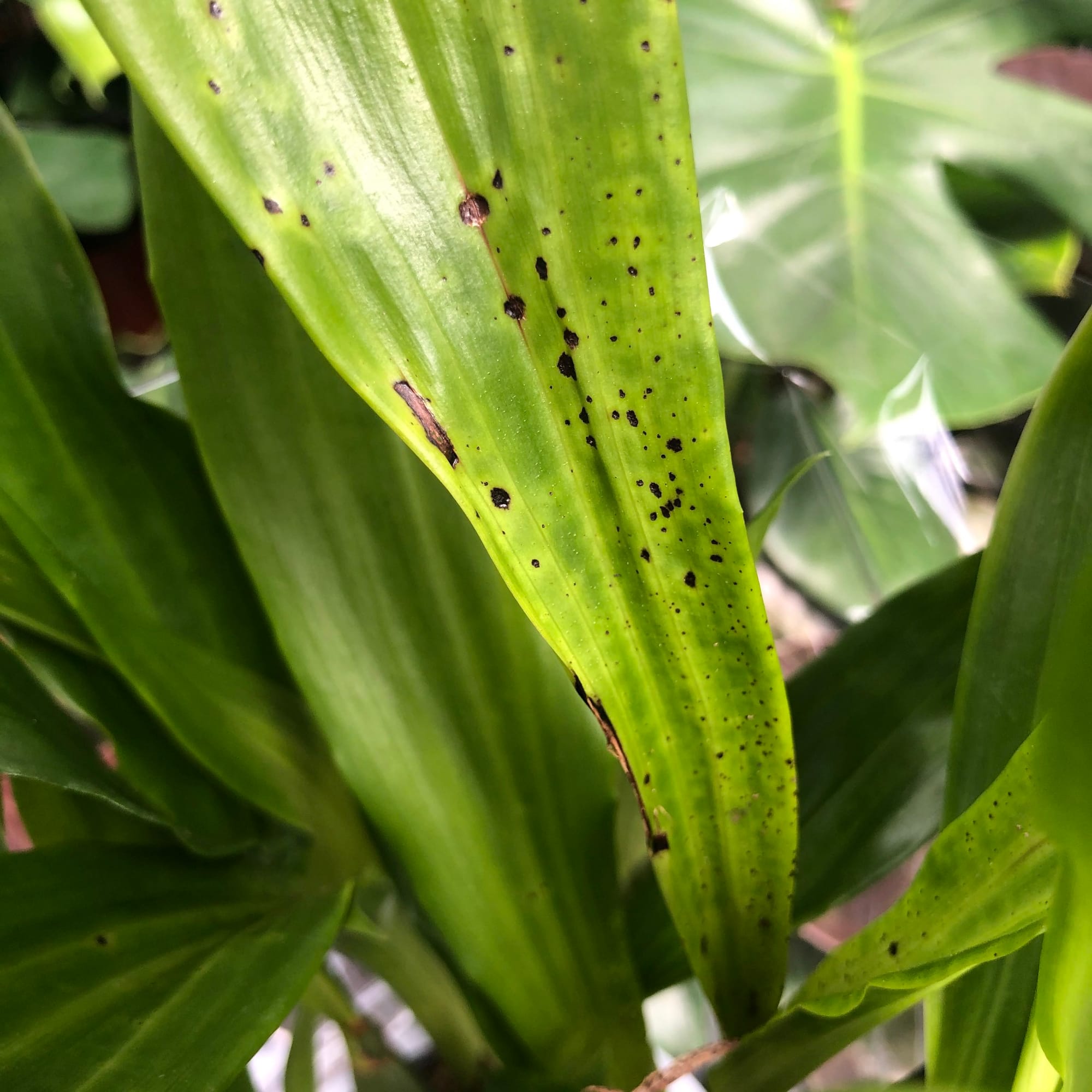 There are several species of Leaf-Spot Disease, (Graphiola, Botrytis, Anthracnose & Cercospora) with all operating similarly. Fungi spores will land on the leaf's surface and will slowly develop along with the plant. Unfortunately, as there aren't any products that'll address the issue head-on, you can only remove the affected areas and regularly wash the leaves to limit the spread. Keep the plant away from unaffected specimens for at least a month after the last symptom.
There are several species of Leaf-Spot Disease, (Graphiola, Botrytis, Anthracnose & Cercospora) with all operating similarly. Fungi spores will land on the leaf's surface and will slowly develop along with the plant. Unfortunately, as there aren't any products that'll address the issue head-on, you can only remove the affected areas and regularly wash the leaves to limit the spread. Keep the plant away from unaffected specimens for at least a month after the last symptom.
Total flower loss can be caused by an array of different issues, including a change in location, too little hydration, too hot or cold temperatures or droughts and pests. While the plant is in bloom, keep the bark evenly moist to hydrate the thirsty work of producing flowers. Locations that are outside of the recommended temperature bracket (below), or have drastic fluctuations must also be kept off the cards. Alternatively, a setting that offers similar temperatures all year round can inhibit blooms. They'll respond very well if the autumn and winter months are a couple of degrees cooler than in summer. In essence, this will not only winterise the plant, but it'll also force it into a dormancy period which is a crucial ingredient for successful flowers. The final issue is pests. Although it's highly unlikely that an infestation will cause a sudden change in health, have a quick inspection for Spider Mites, Aphids and Mealybugs.
Large quantities of aerial roots that cascade over the pot shouldn't cause concern. Once the flowers have fully elapsed, take the plant out of its pot and remove any brown roots when repotting into a bigger pot. If there are a couple still above the soil, either direct them face-down into the compost or allow them to carry on cascading. Be sure to mist the aerial roots while watering the bark to ensure sufficient hydration. If they begin to split, it's the result of too little water or humidity or sun-scorch. Remove once they've fully yellowed over.
Botrytis Petal Blight is small spots or patches that'll develop on the flowers' bodies, usually caused by misting or an over-humid location with poor air circulation. Remove the infected flowers or the complete stalk with sterile utensils to put a stop the airborne disease. Improve the air circulation and move to a slightly brighter location with no direct sunlight. Be careful not to saturate the flowers from there on in, and regularly inspect to see if it has spread. Click here for more info - Common Orchid Diseases.
Origins
Oncidiums were first described back in 1800 by Olof Swartz, using the Greek word "onkos" to refer to lower lip's swelling callus. Although there are only two cultivars of Oncidium currently available on the market, there are over 700 species within the genus, making it one of the largest within Orchidaceæ!
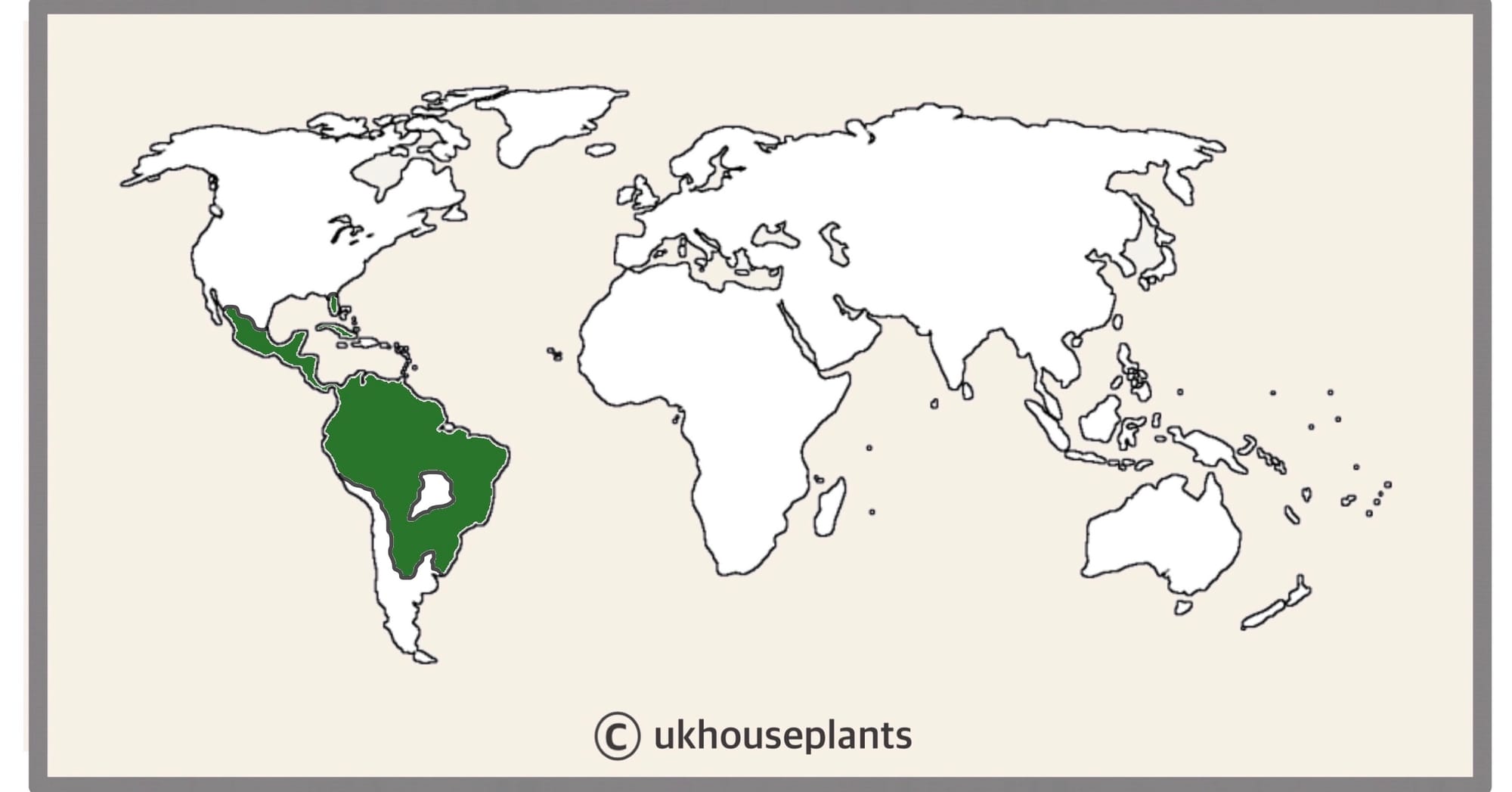 The Distribution of Oncidium.
The Distribution of Oncidium.
Temperature
12° - 27°C (54° - 80°F)
H1b (Hardiness Zone 12) - Can be grown outdoors during the summer in a sheltered location with temperatures above 12℃ (54℉), but is fine to remain indoors, too. If you decide to bring this plant outdoors, don't allow it to endure any direct sunlight as it may result in sun-scorch and dehydration. Regularly keep an eye out for pests, especially when re-introducing it back indoors.
Spread
Up to 0.4m in height & width. Maturity can be achieved in around 5 - 8 years, with several new basal offsets grown per season.
Pruning & Maintenance
Remove yellow or dying leaves, and plant debris to encourage better-growing conditions. While pruning, always use clean scissors or shears to reduce the chance of bacterial and fungal diseases. Never cut through yellowed tissue as this may cause further damage in the likes of diseases or bacterial infections. Remember to make clean incisions as too-damaged wounds may shock the plant, causing weakened growth and a decline in health. Do not cut the pseudobulb off after flowering as its leaves will still provide vital nutrients.
Propagation
Via Seed, Basal Offset Divison & 'Keiki' Cuttings.
Seeds (Difficult & Long-Winded) - Place the seeds on some seaweed agar in a transparent tub (with a lid). Close the lid to maintain high humidity and situate the tub in a bright, indirect setting with bottom-heat of 25℃ (77℉). Germination may take up to three months, so don't discard any unsuccessful seeds until this threshold has been exceeded. Don't open the tub until they reach a maturity state (up to nine months) for the prevention of disease. Remove the seedlings once they surpass two inches in height, along with an adequate amount of roots. Add water to the agar to remove it from the plant and set them in a 5cm (2 inches) bed of Orchid Bark. Maintain high humidity and bright indirect light to alleviate the severity of environmental shock, which can be achieved using a pebble tray. Follow the care requirements mentioned at the top.
Basal Offset Division (Easy) - It's best to divide between spring and summer with plantlets that are at least a third of the size of the mother plant with several developed roots. Take the plant out of its pot and place your hand in between the two plants; soil may have to be removed to get a better grip. While placing your hand as close to the nodal junction, gently push the pup downwards, while supporting the mother plant - you should hear a snap. Cautiously separate both the mother plant and pup's roots systems, keeping great empathise in keeping the roots intact and undamaged. Place the new plantlet in an Orchid Bark, much similar to the original soil, and maintain the same care routines. Don't use a pot that is too big as a ratio of roots-soil that much leans towards the latter will cause root rot.
'Keiki' Cuttings (Easy) - Small offsets, or 'Keiki's', will develop along the mother plant's flower stalks on various non-flowering nodes. Once the roots are more than 3cm (2 inches) in length, cut the Keiki off, keeping a small section of stem either side to the joining. Pot the plantlet's bottom half into Orchid Bark, avoiding the risk of over-potting it, which could result in rotten foliage. Immediately give it a splash of water, preventing excess moisture from settling on the foliage or cubbyholes. In terms of cultivation, provide a bright indirect setting with good air circulation and a humidity tray.
Flowers
Oncidiums will flower naturally in the parameters of late autumn to early spring, producing up to five lateral branches along with the main flower shaft. Each stem can hold up to twenty inflorescences, lasting up to fourteen days, with the overall show lasting eight weeks. Remember to avert the risk of sudden flower loss by keeping the plant relatively moist soil.
Repotting
Infrequent repots will restrict its growth for a potential bloom. They'll be under threat by the challenging environment, and as they'll potentially die (so they think), a flower shaft will be produced to pass on its genes to the next generation.
Repot every three or four years in spring (& when not in bloom) using a mixture of Houseplant Compost and Orchid bark and the next sized pot with adequate drainage. Don't worry if you snap the Velamen (white spongy epidermis) that covers the roots as it'll re-fuse again within the following few weeks. Hydrate the plant 24hrs before tinkering with the roots to prevent the risk of transplant shock. For those that are situated in a darker location, add a thin layer of broken polystyrene in the pot's base to improve drainage & air circulation, and to downplay over-watering. Click here for a detailed step-by-step guide on transplantation, or via this link to learn about repotting with root rot.
Pests & Diseases
Keep an eye out for mealybugs, spider mites, scale, thrips, vine weevils & root mealybugs. Please be aware that applying general pesticide or spray could damage both the plant's foliage when used excessively. Common diseases include collar rot, root rot, botrytis petal blight, guignardia, black rot & anthracnose - click on this link to learn more about addressing these issues.
Toxicity
Not known to be poisonous by consumption of pets and humans. If high quantities are eaten, it may result in vomiting, nausea and a loss of appetite.
Retail Locations
Many supermarkets and garden centres will unreliably stock Oncidiums throughout the year, but most specimens are sold from early winter till late spring. We'd recommend Cameleon for the best range and quality Orchids.
Book a 1-to-1 Call with THE HOUSEPLANT DOCTOR™
If you need further advice with your houseplants, book an advice call with ukhouseplants' friendly and expert writer today! This can be done via a video or audio call on most apps, including Facebook, FaceTime & Skype. A ten-minute call costs £5.99 (US$7), or £15.99 for thirty minutes. You can ask multiple questions, including queries on plants, pests, terrariums, repotting advice and anything in between. Please consider supporting this service to keep ukhouseplants thriving!